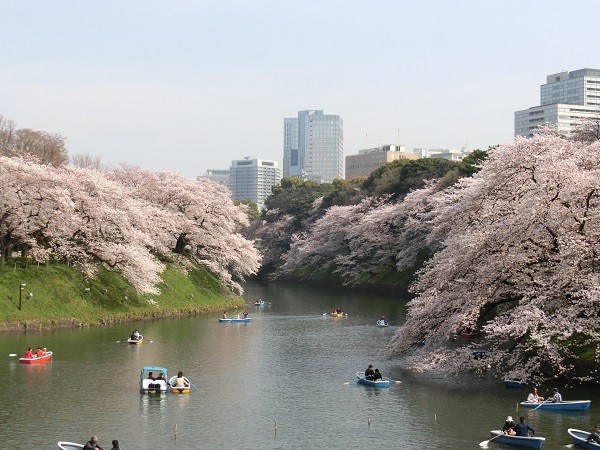March is a month that all the Japanese people are waiting for. That’s because it is the season of the lovely cherry blossoms. The appearance of the pink flowers heralds many things; it is a symbol of spring after the long cold winter and a new start. In Japan, because the school year starts in April and finishes in March, April is the start of many new beginnings. Around the time the blossoms are expected, the news is full of announcements of when they are forecast to start blooming, that is how big a deal it is. Chidorigafuchi is one of the best spots in Tokyo to celebrate their coming!

Hanami or Cherry Blossom Viewing
Many people enjoy a tradition called ‘hanami’ or cherry blossom viewing. It usually coincides with the school spring break, and many people travel far to enjoy hanami. Early April is also the time when the newly hired office workers start to work. To welcome them, companies often hold lively cherry blossom viewing parties in the evening under the cherry blossoms.
Many foreign tourists ask us “Where can we see the best cherry blossoms?” Tourists especially like to enjoy the blossoms accompanied by a traditional Japanese background such as temples, shrines, Japanese gardens, and local cherry blossom viewing parties. If you are looking for a place in Tokyo, Chidorigafuchi is one of the most impressive cherry blossom hot spots in the city.
About Chidorigafuchi
Chidorigafuchi is a moat surrounding the Imperial Palace. The ground of Imperial Palace used to be the ground of Edo Castle which was constructed more than 400 years ago by the Tokugawa Shogun. The moat is a part of the castle that protects the castle from enemies accessing easily. Some parts of the moat are surrounded by stone walls, but Chidorigafuchi’s bank is made of soil, so it looks like a natural riverbank.
The 15th Shogun of Tokugawa resigned and left the castle in 1867. The following year in 1868, Emperor Meiji moved from Kyoto to Tokyo. Since then, it has become the Imperial Palace. Ever since, the area of Chidorigafuchi has become a public space so you can visit freely.
Chidorigafuchi Cherry Blossoms
From the northern end: if you approach the moat from the northern part, the large avenue Yasukuni-dori, you can look through the waterway stretching straight toward the south. More than 400 cherry trees are planted on both sides of the moat. They are mostly of the type known as Someiyoshino, the most typical cherry trees in Japan for flower viewing. Because the cherry trees are spreading their branches toward the water, the whole bank is covered with pink flowers. Some branches even almost touch the water. It is a gorgeous view!
Chidorigafuchi Ryokudo Walkway: After you enjoy the whole view, I recommend walking through the Chidorigafuchi Ryokudo walkway from the viewpoint. You can walk under the cherry trees which means you will feel like you’re walking through the pink tunnel.
Riding a Boat: Another good way to enjoy the cherry blossoms is rowing a small boat for 2 or 3 people. It is also nice to look up at the cherry blossoms from the water level. Cherry branches hang downward from the trunk and make you feel like you are surrounded by pink clouds.
Evening View: Cherry trees are lit up in the evening during the cherry blossom season. You can enjoy a different atmosphere with illumination while walking through the Chidorigafuchi Ryokudo.
Yasukuni Shrine Flowers
Next to the Chidorigafuchi, there is a large Shinto shrine called Yasukuni Shrine. It was constructed in 1869 to enshrine the people who lost their lives in the Meiji Restoration, which was a big event that saw Japan go from the Samurai period to the modern period by terminating the Shogunate. It was a peaceful revolution, because the Shogun announced resignation without any war. But before and after his resignation, there was civil war and many people lost their lives. The shrine added more victims of other wars later, including WW2 which has caused controversy.
It is also a good place to appreciate cherry blossoms. The ‘sample cherry tree’ of Tokyo is located here, which means that when several flowers of this tree start to bloom, Tokyo declares that the cherry blossoms started blooming. There are many cherry trees in the precinct. During the cherry blossom season, there are a lot of temporary food stalls at the entrance of the shrine which are open until the late evening. You can try typical Japanese fast food such as takoyaki (octopus balls), okonomiyaki (Japanese pancakes), and yakisoba (fried noodles).
Nihon Budokan Stadium
If you are in the area, it is also worth stopping by the Nihon Budokan Stadium. Nihon Budokan is a stadium that was built in 1964 for the Judo matches of the first Tokyo Olympic Games. By ‘budo’, we mean Japanese martial arts. But the term is used for many other sports and also for music concerts. The most significant event that has been held here was the concert of The Beatles in 1966. There were a lot of objections to the concert. Many people thought that rock’n’roll was not suitable for Nihon Budokan because it is a place for martial arts which are sacred sports in Japan. Now, there are no objections to any events anymore.
Your Japan Tour
As seasoned Japan experts, we can help you create your perfect Japan tour including guides who can tell you all about the culture related to cherry blossoms. The guides can also take you to the best places to enjoy hanami including Chidorigafuchi and the Yasukuni Shrine. Contact us to start planning your unforgettable holiday to this fascinating country full of once-in-a-lifetime experiences, culture, history, nature, and delicious food!
Information
Access: The nearest station is Kudanshita (Tozai Line and Toei Shinjuku Line)
